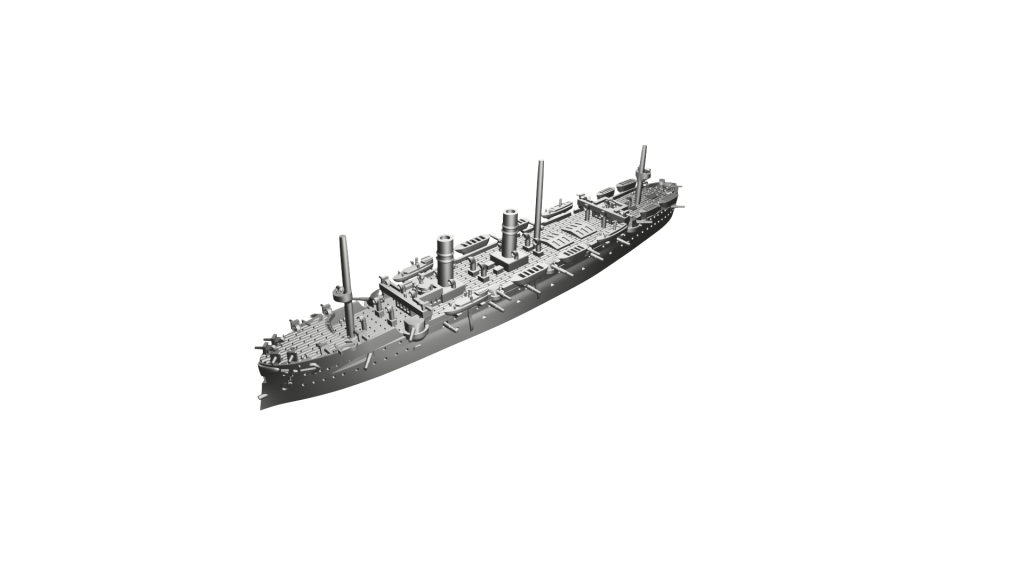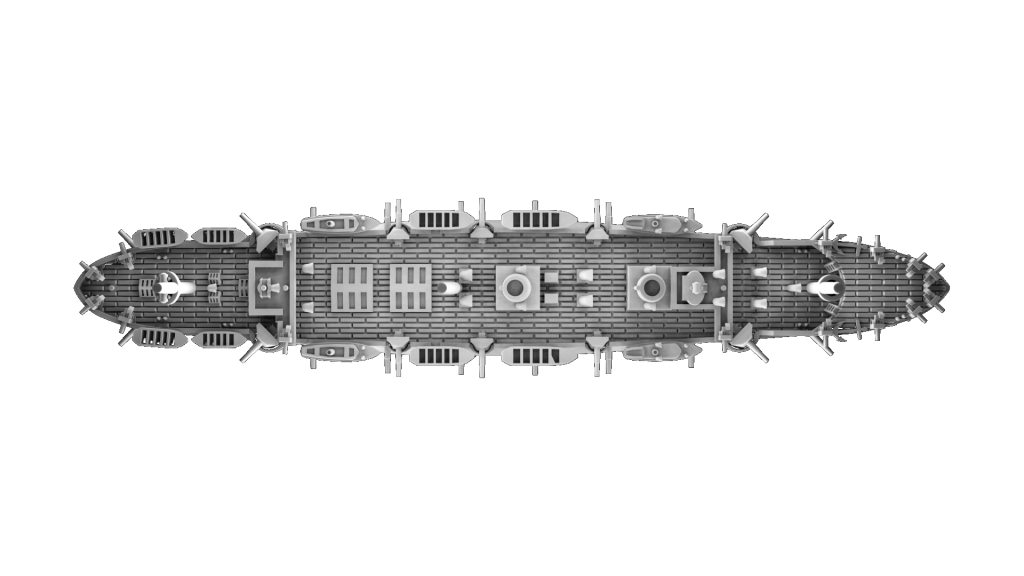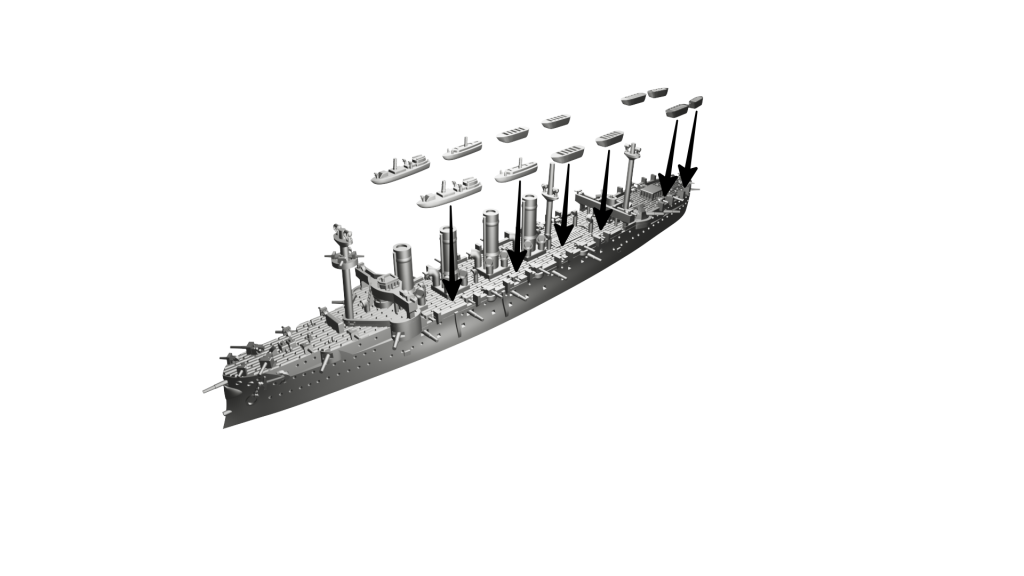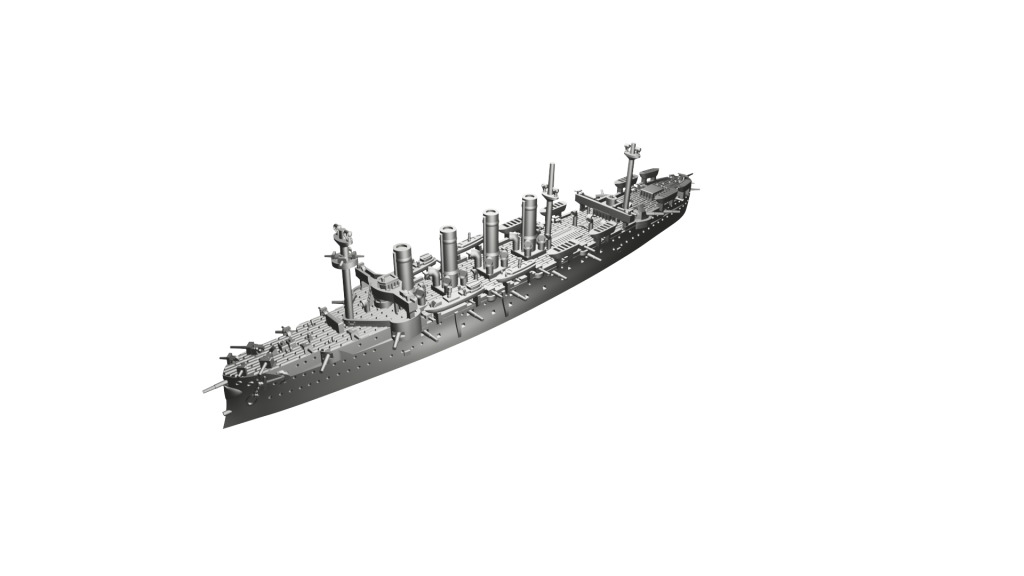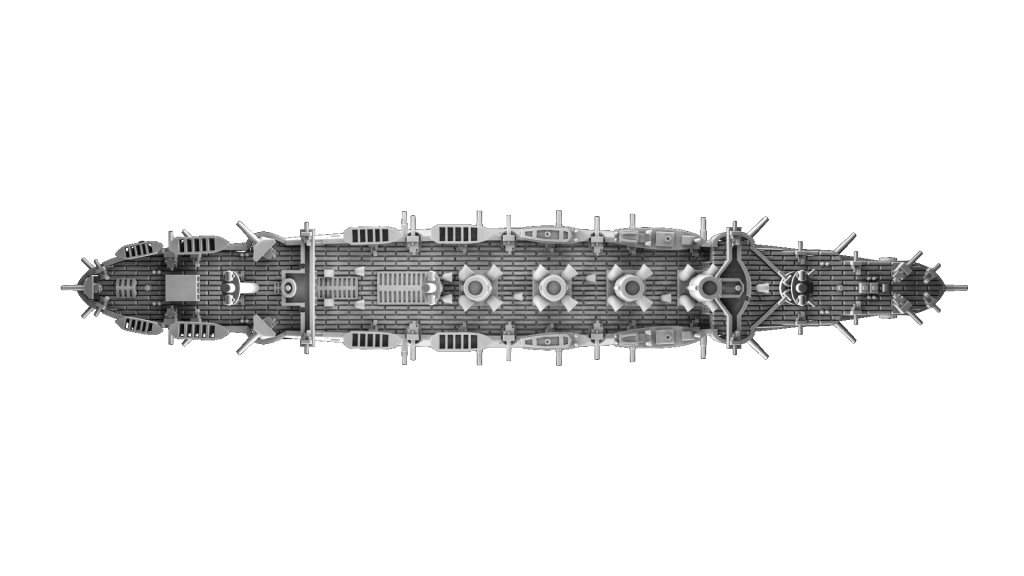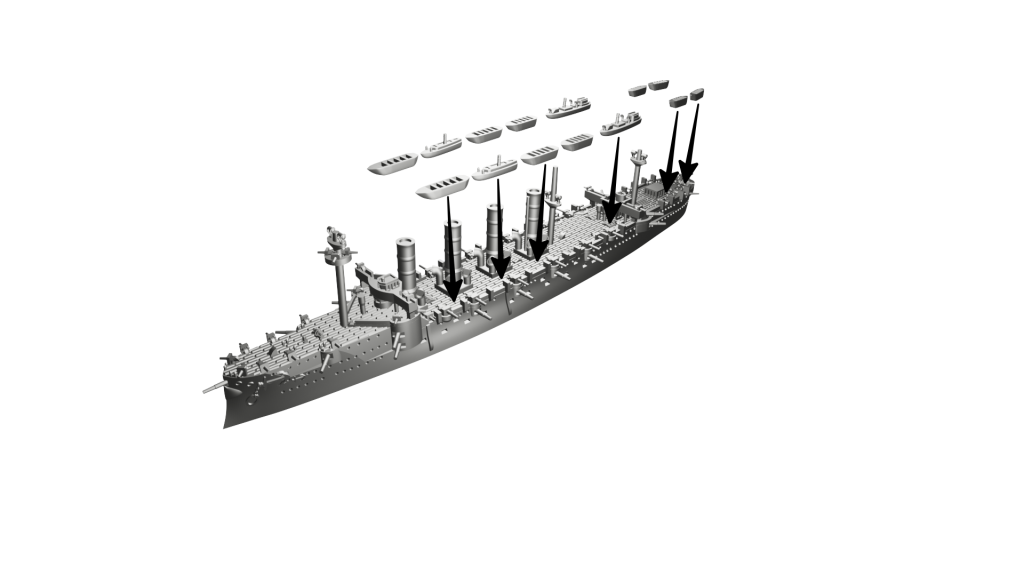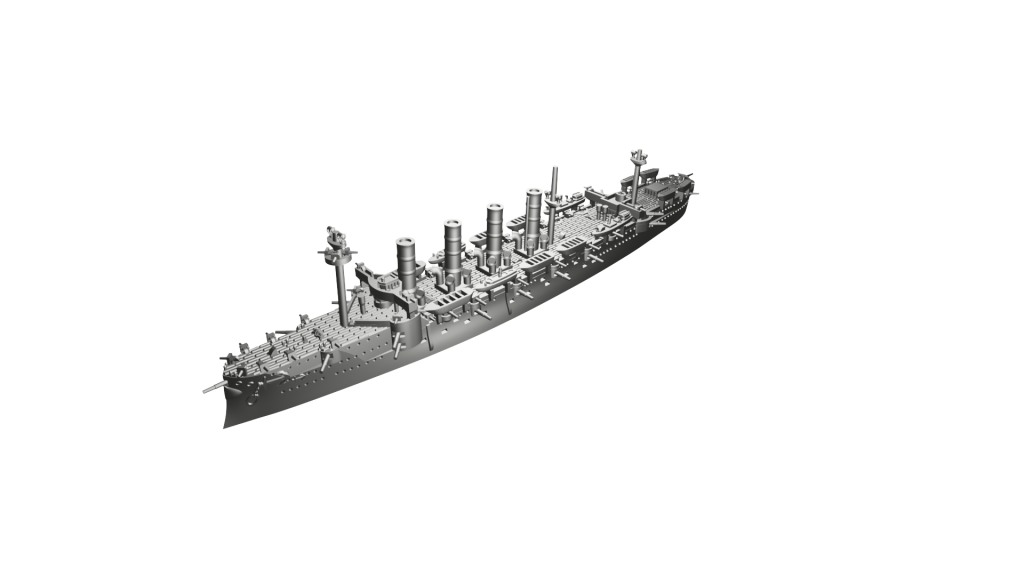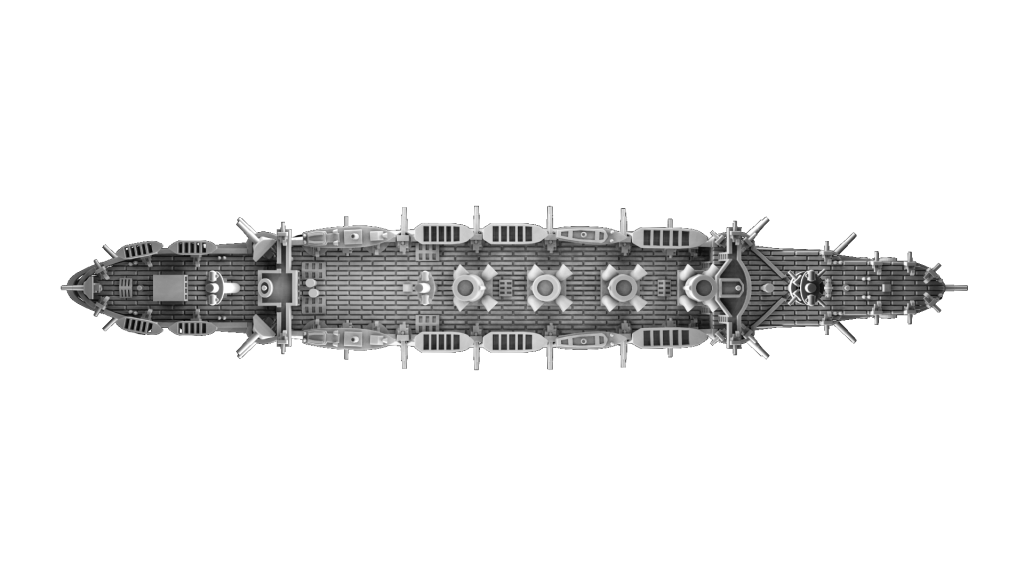General information
The painting instructions for Russian ships can be found here: LINK. This page contains only basic information about the models and ships, along with the painting scheme that should be applied (the instructions on the linked page show what the specific scheme looks like).
Due to geography, Russia had to divide its fleet into many squadrons operating in different seas and oceans. The tsar, however, wanted to spend a lot of money on the development of a modern fleet, using the experience of Western countries (mainly France), but also building his own capabilities. The Russian fleet has universal capabilities in all ship classes and is very diverse.
Most of the Russian battleships will be comparable to similar designs in other countries.
The cruisers were built for raids, they would be fast and well armed, but not with the best armor. One of them – Novik, is the fastest ship in her class in the game.
The Russian destroyers were of good quality, although sometimes poor quality control meant that some units, such as torpedo boats, had poor engine rooms and reached speeds much worse than planned.
6th Era – predrednoughts
GMT-RUS-001 Russian Navy Squadron
This is the perfect set for the beginning of the adventure with the JapaneseRussian fleet. It includes the following:
Ship models:
– Borodino class battleship,
– Varyag protected cruiser,
– Pallada class protected cruiser,
– Novik class cruiser,
– 4 Pernov class torpedo boats (2 for each base)
Dial sets x6
Ship’s cards x7
Card sleeves x7
HDF bases for ships x6

GMT-RUS-002 Borodino class battleship
Class: 1.
Base length: 14 cm.
Color scheme: Baltic fleet.
Models in a set: 1.
Models on one base: 1.
Cards in a set: 1.
The Borodino-class battleships were a group of five pre-dreadnought battleships built for the Imperial Russian Navy around the end of the 19th century. Their design was based on that of the French-built Tsesarevich modified to use Russian equipment.
The Borodino-class battleships are well-armed, capable of reaching 18 knots of speed, and have decent armor, allowing them to engage in combat with any battleship of the era.
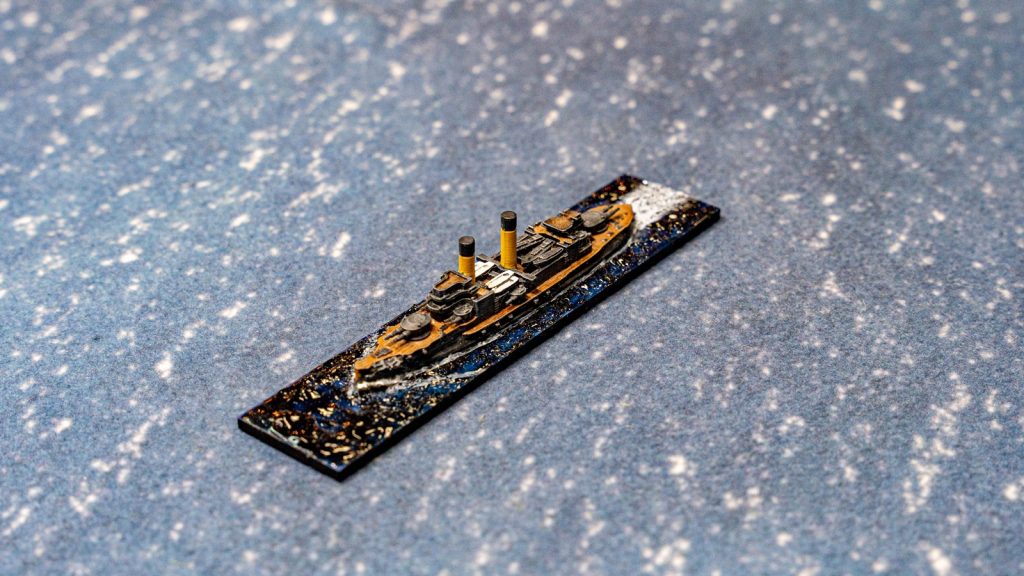


GMT-RUS-003 Admiral Ushakov class coastal batleship
Class: 2.
Base length: 10 cm.
Color scheme: Baltic fleet.
Models in a set: 1.
Models on one base: 1.
Cards in a set: 2.
The Admiral Ushakov class were coastal defense battleships built for the Imperial Russian Navy during the 1890s to counter armored ships of the Swedish Navy. All three ships were stationed in the Baltic Sea when the Russo-Japanese war began and sailed with the Baltic Fleet around the Cape of Good Hope to the Pacific.
Despite her age, Admiral Ushakov will be a valuable ship in the player’s fleet. It is a good idea to keep it away from enemy battleships, although it may cause trouble for them, but it can handle most of the cruisers, as it has stronger armor and weapons.
The ship can be configured in two ways, as Admiral Ushakov and Sieniawin – with a stern turret that had two cannons, or Admiral Apraksin, with a stern turret that had one cannon.


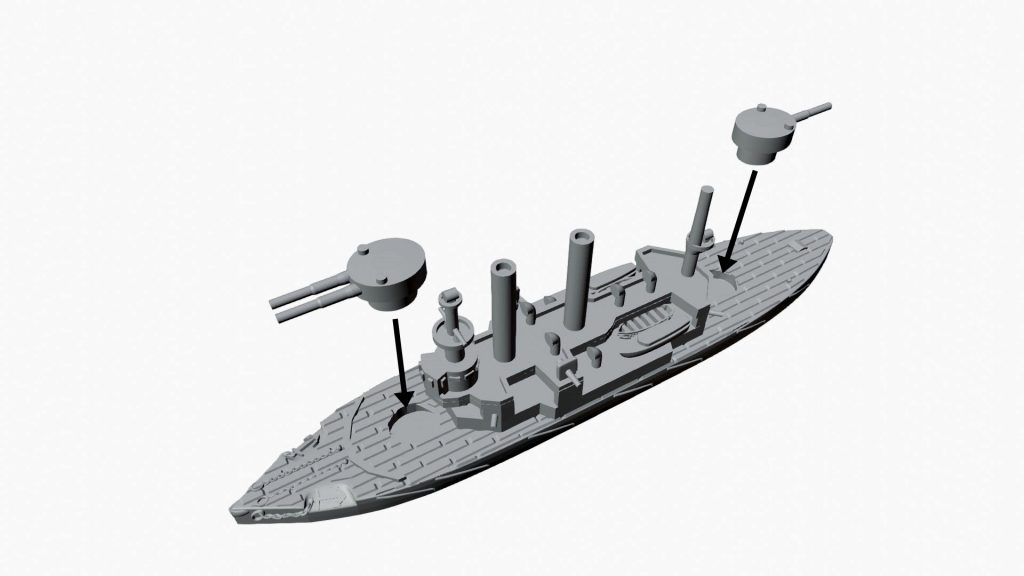
GMT-RUS-004 Pallada class protected cruiser
Class: 2.
Base length: 12 cm.
Color scheme: Baltic fleet (Aurora), Port Arthur squadron (Pallada and Diana).
Models in a set: 1.
Models on one base: 1.
Cards in a set: 1.
The Pallada-class cruisers (often known in Russia as “Diana-type protected cruisers”) were a group of three protected cruisers built for the Imperial Russian Navy (IRN) in the late 1890s. One ship of the class, Aurora, is still crewed by the Russian Navy, and maintained as a museum ship.
These heavily – for their class – armed ships will pose a threat to smaller ships, especially due to the large number of medium and small caliber guns.



GMT-RUS-005 Varyag class protected cruiser
Class: 2.
Base length: 12 cm.
Color scheme: Port Arthur squadron.
Models in a set: 1.
Models on one base: 1.
Cards in a set: 1.
Varyag was a Russian protected cruiser. Varyag became famous for her crew’s stoicism at the Battle of Chemulpo Bay.
The heroic, heavily armed Varyag is one of the best Russian protected cruisers. Well-armored (for protected cruisers), fast and well-armed, it will be a very demanding opponent for ships of comparable size.


GMT-RUS-006 Novik class cruiser
Class: 3.
Base length: 12 cm.
Color scheme: Baltic fleet (Izumrud, Zhemchug), Port Arthur squadron (Novik).
Models in a set: 1.
Models on one base: 1.
Cards in a set: 1.
Novík was a protected cruiser in the Imperial Russian Navy, built by Schichau shipyards in Elbing near Danzig in then Germany. Novik was one of the fastest cruisers in the world at the time.
Thanks to her speed and armament, the Novik will be the perfect ship for fighting destroyers and torpedo boats. But it’s better to keep him away from heavy ships, which will be easy thanks to his great speed.




GMT-RUS-007 Korietz class gunboat
Class: 4.
Base length: 8 cm.
Color scheme: Peacetime colors (Korietz), Port Arthur squadron (Mandzhur).
Models in a set: 2.
Models on one base: 1.
Cards in a set: 2.
Korietz (literally meaning “Korean person”) was a gunboat in Russian Imperial Navy. She was the lead vessel in a class of eight ships in her class.
Korietz, thanks to its very strong armament, will come as a surprise to much larger ships, not to mention destroyers or torpedo boats.


GMT-RUS-008 Buinyi class destroyer
Class: 4.
Base length: 8 cm.
Color scheme: Baltic fleet, Port Arthur squadron.
Models in a set: 4.
Models on one base: 2.
Cards in a set: 2.
Buinyi was a typical early 20th century destroyer. Displacing around 400 tonnes and developing well over 20 knots, it was large enough to be able to sail the open oceans, although it was poor in handling stormy weather. Strong torpedo armament and decent artillery armament made ships of this type the real workhorses of the fleet. Buinyi will also play a role in your fleet, posing a threat to large enemy ships.


GMT-RUS-009 No. 208 class torpedo boat
Class: 4.
Base length: 6 cm.
Color scheme: Baltic fleet, Port Arthur squadron.
Models in a set: 4.
Models on one base: 2.
Cards in a set: 2.
The torpedo ships were the hope of those navies who could not afford many larger ships. However, their low displacement made them very difficult to cope with rough seas. Moreover, with the advent of torpedo boats, many ships began to be equipped with light artillery to counteract them.
The No. 208 was based on the French design, but the disadvantage of these units – for ships of this class – was their low speed, which made it difficult to approach the enemy quickly.


GMT-RUS-010 Peresvet class battleship
Class: 1.
Base length: 14 cm.
Color scheme: Baltic fleet (Oslabya), Port Arthur squadron (Peresvet, Pobeda).
Models in a set: 1.
Models on one base: 1.
Cards in a set: 2.
Peresvet was designed in the mid-1890s as a high-speed, long-range battleship that could support Russian armored cruisers in raiding operations. The long range was paid for with weaker armor than typical battleships of the era (except Pobeda, which had Krupp armor). This ship will therefore be a cheaper (in points) alternative to the Borodino class, due to the large number of cannons, which is a threat to both battleships and cruisers of the enemy. Their additional advantage is the ability to purchase the minelayer option!
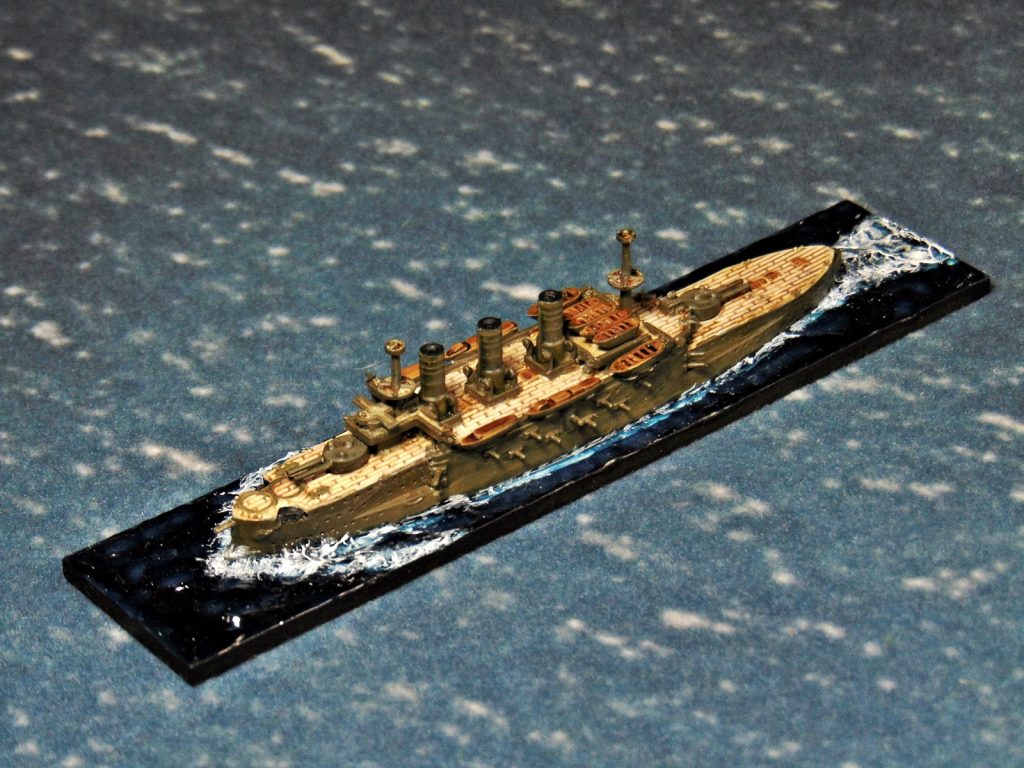


GMT-RUS-011 Askold protected cruiser
Class: 2.
Base length: 14 cm.
Colour scheme: Port Arthur squadron.
Models in a set: 1.
Models on one base: 1.
Cards in a set: 1.
Askold was a protected cruiser built for the Imperial Russian Navy, named after the legendary Varangian ruler of Kiev. Her thin, narrow hull and maximum speed of 23.8 knots were considered impressive for the time. She had five thin funnels which gave her a unique silhouette for any vessel in the Imperial Russian Navy.
From the start of the Russo-Japanese War of 1904-1905, Askold was one of the most active vessels in the Russian fleet.
The cruiser’s high speed, durability, and good (for protected cruisers) armour characteristics make it a very useful ship in the player’s fleet, excelling in encounters with other cruisers and smaller vessels. Additionally, its unique 5-funnel silhouette will give it an unmistakable appearance on the gaming table.



GMT-RUS-012 Tsesarevich pre-drednought battleship
Class: 1.
Base length: 12 cm.
Colour scheme: Port Arthur squadron.
Models in a set: 1.
Models on one base: 1.
Cards in a set: 1.
Tsesarevich was a pre-dreadnought battleship of the Imperial Russian Navy, built in France. Construction began on 18 May 1899, the ship was laid down on 8 July 1899 and launched on 23 February 1901.
Her design was based on that of the French battleship Jauréguiberry, with a few changes.
Tsesarevich’s most obvious design feature was her tumblehome hull, which allowed greater freeboard, but it reduced buoyancy and stability.
She was based at Port Arthur, northeast China, after entering service and fought in the Russo-Japanese War of 1904–1905, and become the flagship of Rear Admiral Wilgelm Vitgeft in the Battle of the Yellow Sea. After the battle she was interned in Qingdao.
Tsesarevich is the most powerful and best battleship in the Russian fleet. Excellently armed, the best-armoured among all Russian battleships, and distinguished by an incredible silhouette, it will undoubtedly be one of the most popular choices for players.

GMT-RUS-013 Admiral Nakhimov armoured cruiser
Class: 2.
Base length: 12 cm.
Colour scheme: Baltic fleet.
Models in a set: 1.
Models on one base: 1.
Cards in a set: 1.
Admiral Nakhimov (named after Admiral Pavel Nakhimov), was an armoured cruiser in the Imperial Russian Navy during the Russo-Japanese War.
Admiral Nakhimov was ordered in 1881 as one of the first armoured cruisers, and laid down at the Baltic Shipyard in Saint Petersburg in the presence of Tsar Alexander III in July 1884, launched on 21 October 1885, and entered service on 9 September 1888.
By 1905 she was already an obsolete vessel.
Despite its relatively weak armour and moderate speed, Admiral Nakhimov will be an attractive ship for the player, not only visually but also in terms of usefulness in battle. If it manages to get close to the opponent, its numerous artillery will be able to showcase its destructive power, especially against protected cruisers.



GMT-RUS-014 Forel-class (Vnimatielnyi) torpedo boat destroyer
Class: 4.
Base length: 8 cm.
Colour scheme: Port Arthur squadron.
Models in a set: 4.
Models on one base: 2.
Cards in a set: 2.
Construction of the first ship in this series began in 1899 and was completed two years later. In 1902, all ships of this class received new names, with Forel being renamed Vnimatielnyj.
Forel class was officially classified by Russians as torpedo boats. Despite the official classification, these ships, displacing over 300 tons, were decidedly closer to the destroyers of that time than torpedo boats. These vessels were inspired by the French destroyer of the Durandal type, although they differed in certain aspects, such as the silhouette – Forel had 4 funnels, grouped in pairs.
All ships of this type were sent to Port Arthur and participated in the Russo-Japanese War of 1904-1905.
Forel has fewer torpedo tubes than other Russian destroyers, making it competitively priced. Therefore, it represents a very attractive alternative to other Russian 4-class ships.


GMT-RUS-015 Vladivostok Cruiser Squadron
GMT-RUS-015 Rurik armoured cruiser
Class: 2.
Base length: 14 cm.
Colour scheme: Vladivostok Cruiser Squadron.
Models in a set: 1
Models on one base: 1
Cards in a set: 1
The Rurik armoured cruiser built in 1892, was named after the legendary Varangian warrior and founder of the Rurikid dynasty. The ship displaced nearly 11,000 tons and was armed with 4×203 mm guns, 16×152 mm guns, 6×120 mm guns, 6×47 mm guns, 10×37 mm guns, and 6 torpedo tubes. Her armament was often supplemented with 1-pounder guns.
The Rurik was designed for countering enemy shipping and was expected to have the ability to undertake long, independent voyages across the world’s oceans in various weather conditions.
Her armour, though thick, was of the “belt” type—narrow but thick strips protecting a limited portion of the ship’s side. This soon proved inadequate. The heavy armament and thick armour, however, took a toll on the ship’s maximum speed—only 18 knots, which was faster than contemporary battleships but ultimately too slow.
During the Russo-Japanese War, the Rurik was part of the Vladivostok squadron and participated in numerous raids against Japanese shipping, including the sinking of the Hitachi Maru. It was eventually sunk in the Battle of Ulsan by Japanese armoured cruisers.
Nevertheless, the Rurik would have been a valuable reinforcement for the Russian fleet, with strong firepower and durability, making her a significant threat to any enemy cruiser.
GMT-RUS-015 Rossia armoured cruiser
Class: 2.
Base length: 14 cm.
Colour scheme: Vladivostok Cruiser Squadron.
Models in a set: 1
Models on one base: 1
Cards in a set: 1
The Rossia armoured cruiser was commissioned into service in 1896. Although there were initially plans to build three ships of the Rurik class, it became clear that the Rurik’s specifications were insufficient for the intended role. This led to the decision to design entirely new, larger units. The result was the Rossia, followed by the Gromoboi shortly afterward.
The ship measured about 147 meters in length and displaced over 12,000 tons. Her primary mission was to conduct long-range raids against enemy shipping. The Rossia could achieve a speed of 19 knots and was armed with 4×203 mm guns, 16×152 mm guns, 12×75 mm guns, 20×47 mm guns, 18×37 mm guns, and 5 torpedo tubes.
While the armour of the Rossia was relatively thick, the ship was not as evenly armoured as, for example, the famous Garibaldi-class cruisers. This was due to the role she was designed for in wartime—operating as a long-range raider.
In this role, the Rossia was used during the Russo-Japanese War of 1904-1905, participating in actions such as the sinking of the Hitachi Maru and the Battle of Ulsan.
Her armament made it one of the most heavily armed Russian ships, posing a serious threat to any enemy cruiser. This makes her one of the most valuable vessels in the Tsar’s fleet.
GMT-RUS-015 Gromoboi armoured cruiser
Class: 2.
Base length: 14 cm.
Colour scheme: Vladivostok Cruiser Squadron.
Models in a set: 1
Models on one base: 1
Cards in a set: 1
The Gromoboi armoured cruiser was commissioned into service in 1899. Although there were initially plans to build three ships of the Rurik class, it became clear that the Rurik’s specifications were insufficient for the requirements. This led to the design of entirely new, larger ships. The Gromoboi was one of the results.
She measured about 147 meters in length and displaced over 12,500 tons. She was built to conduct long-range raids against enemy shipping. The Gromoboi could reach a speed of 19 knots and was armed with 4×203 mm guns, 16×152 mm guns, 24×75 mm guns, 12×47 mm guns, 18×37 mm guns, and 4 torpedo launchers.
Although her armour was relatively thick, she was not as evenly armoured as, for example, the famous Garibaldi-class cruisers. This was due to the role she was designed for in wartime—operating as a long-range raider.
In this role, the Gromoboi was used during the Russo-Japanese War of 1904-1905, participating in actions such as the sinking of the Hitachi Maru and the Battle of Ulsan.
Her armament made her one of the most heavily armed Russian ships, posing a real threat to any enemy cruiser. This makes her one of the most valuable units in the Tsar’s fleet.





